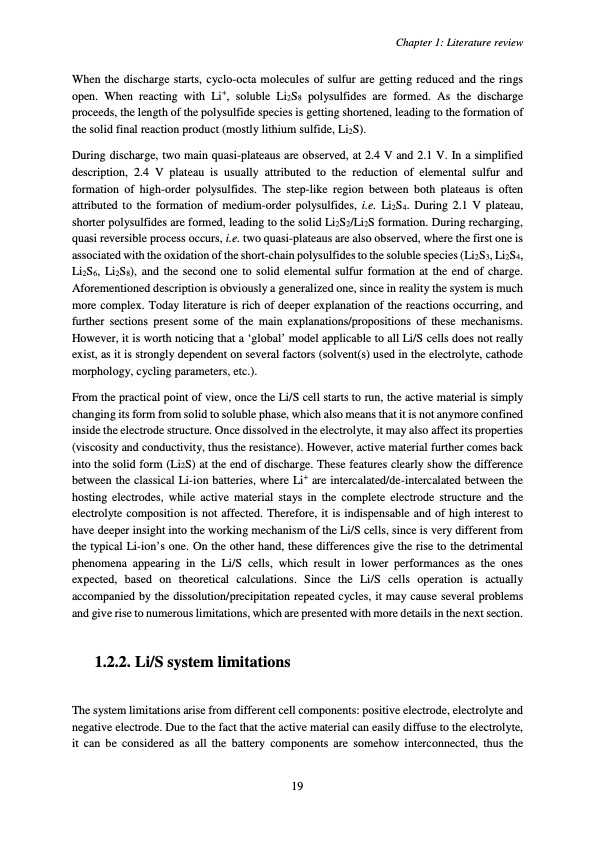
PDF Publication Title:
Text from PDF Page: 023
When the discharge starts, cyclo-octa molecules of sulfur are getting reduced and the rings open. When reacting with Li+, soluble Li2S8 polysulfides are formed. As the discharge proceeds, the length of the polysulfide species is getting shortened, leading to the formation of the solid final reaction product (mostly lithium sulfide, Li2S). During discharge, two main quasi-plateaus are observed, at 2.4 V and 2.1 V. In a simplified description, 2.4 V plateau is usually attributed to the reduction of elemental sulfur and formation of high-order polysulfides. The step-like region between both plateaus is often attributed to the formation of medium-order polysulfides, i.e. Li2S4. During 2.1 V plateau, shorter polysulfides are formed, leading to the solid Li2S2/Li2S formation. During recharging, quasi reversible process occurs, i.e. two quasi-plateaus are also observed, where the first one is associated with the oxidation of the short-chain polysulfides to the soluble species (Li2S3, Li2S4, Li2S6, Li2S8), and the second one to solid elemental sulfur formation at the end of charge. Aforementioned description is obviously a generalized one, since in reality the system is much more complex. Today literature is rich of deeper explanation of the reactions occurring, and further sections present some of the main explanations/propositions of these mechanisms. However, it is worth noticing that a ‘global’ model applicable to all Li/S cells does not really exist, as it is strongly dependent on several factors (solvent(s) used in the electrolyte, cathode morphology, cycling parameters, etc.). From the practical point of view, once the Li/S cell starts to run, the active material is simply changing its form from solid to soluble phase, which also means that it is not anymore confined inside the electrode structure. Once dissolved in the electrolyte, it may also affect its properties (viscosity and conductivity, thus the resistance). However, active material further comes back into the solid form (Li2S) at the end of discharge. These features clearly show the difference between the classical Li-ion batteries, where Li+ are intercalated/de-intercalated between the hosting electrodes, while active material stays in the complete electrode structure and the electrolyte composition is not affected. Therefore, it is indispensable and of high interest to have deeper insight into the working mechanism of the Li/S cells, since is very different from the typical Li-ion’s one. On the other hand, these differences give the rise to the detrimental phenomena appearing in the Li/S cells, which result in lower performances as the ones expected, based on theoretical calculations. Since the Li/S cells operation is actually accompanied by the dissolution/precipitation repeated cycles, it may cause several problems and give rise to numerous limitations, which are presented with more details in the next section. 1.2.2. Li/S system limitations The system limitations arise from different cell components: positive electrode, electrolyte and negative electrode. Due to the fact that the active material can easily diffuse to the electrolyte, it can be considered as all the battery components are somehow interconnected, thus the 19 Chapter 1: Literature reviewPDF Image | Accumulateur Lithium Soufre

PDF Search Title:
Accumulateur Lithium SoufreOriginal File Name Searched:
WALUS_2015_archivage.pdfDIY PDF Search: Google It | Yahoo | Bing
Sulfur Deposition on Carbon Nanofibers using Supercritical CO2 Sulfur Deposition on Carbon Nanofibers using Supercritical CO2. Gamma sulfur also known as mother of pearl sulfur and nacreous sulfur... More Info
CO2 Organic Rankine Cycle Experimenter Platform The supercritical CO2 phase change system is both a heat pump and organic rankine cycle which can be used for those purposes and as a supercritical extractor for advanced subcritical and supercritical extraction technology. Uses include producing nanoparticles, precious metal CO2 extraction, lithium battery recycling, and other applications... More Info
| CONTACT TEL: 608-238-6001 Email: greg@infinityturbine.com | RSS | AMP |